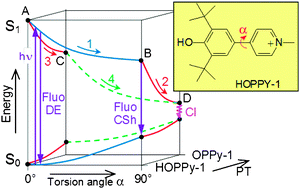Excited-state dynamics of phenol–pyridinium biaryl†
Abstract
The excited-state dynamics of a donor–acceptor

* Corresponding authors
a Institut de Sciences des Matériaux de Mulhouse, LRC CNRS 7228, Université de Haute Alsace, 15 rue Jean Starcky, 68057 Mulhouse, France
b Laboratoire de Chimie Organique et Bioorganique, Université de Haute Alsace, ENSCMu, 3 rue Alfred Werner, 68093 Mulhouse, France
c
Institut für Chemie, Humboldt-Universität zu Berlin, Brook-Taylor-Str. 2, 12489 Berlin, Germany
E-mail:
rettig@chemie.hu-berlin.de
Fax: +49 30-2093-5574
Tel: +49 30 2093 5585
d Département de Photochimie Générale, Université de Haute Alsace, ENSCMu, 3 rue Alfred Werner, 68093 Mulhouse, France
e
Laboratoire de Spectrochimie Infrarouge et Raman (UMR 8516 de l'Université et du CNRS), Université Lille 1 Sciences et Technologies, Bât. C5, 59655 Villeneuve d'Ascq cedex, France
E-mail:
olivier.poizat@univ-lille1.fr
Fax: +33 3 20 43 67 55
Tel: +33 3 20 43 40 85
The excited-state dynamics of a donor–acceptor

 Please wait while we load your content...
Something went wrong. Try again?
Please wait while we load your content...
Something went wrong. Try again?
J. Malval, H. Chaumeil, W. Rettig, V. Kharlanov, V. Diemer, E. Ay, F. Morlet-Savary and O. Poizat, Phys. Chem. Chem. Phys., 2012, 14, 562 DOI: 10.1039/C1CP22829C
To request permission to reproduce material from this article, please go to the Copyright Clearance Center request page.
If you are an author contributing to an RSC publication, you do not need to request permission provided correct acknowledgement is given.
If you are the author of this article, you do not need to request permission to reproduce figures and diagrams provided correct acknowledgement is given. If you want to reproduce the whole article in a third-party publication (excluding your thesis/dissertation for which permission is not required) please go to the Copyright Clearance Center request page.
Read more about how to correctly acknowledge RSC content.
 Fetching data from CrossRef.
Fetching data from CrossRef.
This may take some time to load.
Loading related content
